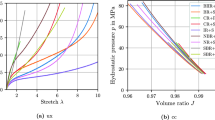Abstract
The possibilities of cellulose acetate as a photoplastic model material used in the uniaxial tension test were presented by the authors in Ref. 1. Empirical formulas were proposed for photoplastic stress analysis considering the effect of strain rate and temperature. In this paper, the stress-strain-optic laws derived from the uniaxial tension test were confirmed precisely under the biaxial stress field. Consequently, the biaxial stress-strain-optic laws of cellulose acetate can be represented by simply substituting the difference of the principal stress and the difference of the principal strain into the terms of the stress and the strain in the empirical formulas for the uniaxial stress state, respectively. Therefore, the empirical formulas considering the influence of strain rate were obtained for the photo-viscoelastoplastic plane-stress analysis during the usual static loading. This method was applied to an elastoplastic problem of a finite plate with a circular hole under uniaxial tension. The distribution of stress and strain, the stress-concentration factors in the elastoplastic region and the development of the plastic region were obtained experimentally taking the rate effect into account. As a result, the stress on a minimum section in a model increased as head speed increased. On the other hand, the distribution of strain, the development of the plastic region and the stress-concentration factors were almost never influenced by head speed.
Similar content being viewed by others
References
Ishikawa, H. andTadano, S., “Mechanical and Optical Characterization of Cellulose Acetate,”Experimental Mechanics,28 (3),221–225 (Sept. 1988).
Arcan, M., Hashin, Z. andVoloshin, A., “A Method to Produce Uniform Plane-stress States with Applications to Fiber-reinforced Materials,”Experimental Mechanics,18 (4),141–146 (1978).
Stowell, E.Z., “Stress and Strain Concentration at a Circular Hole in an Infinite Plate,”NACA Tech. Note 2073, 1–4 (1950).
Marcal, P.V. andKing, I.P., “Elastic-Plastic Analysis of Two-Dimensional Stress Systems by Finite Element Method,”Int. J. Mech. Sci.,9,143–155 (1967).
Theocaris, P.S. andMarketos, E., “Elastic-Plastic Analysis of Perforated Thin Strips of a Strain-hardening Material,”J. Mech. Phys. Solids,12,377–390 (1964).
Durelli, A.J. andSciammarella, C.A., “Elastoplastic Stress and Strain Distribution in a Finite Plate with a Circular Hole Subjected to Unidimensional Load,”J. Appl. Mech., Trans. ASME,85,115–121 (1963).
Frocht, M.M. and Thomson, R.A., “Studies in Photoplasticity,” Proc. 3rd U.S. Nat. Cong. Appl. Mech., 533–540 (1958).
Thomson, R.A. and Frocht, M.M., “Further Work on Plane Elastoplastic Stress Distributions,” Proc. Int. Symp. on Photoelasticity, 185–193 (1963).
Mönch, E. and Loreck, R., “A Study of the Accuracy and Limits of Application of Plane Photoplastic Experiments,” Proc. Int. Symp. on Photoplasticity, 169–184 (1963).
Morris, D.H. andRiley, W.F., “A Photomechanics Material for Elastoplastic Stress Analysis,”Experimental Mechanics,12 (10),448–453 (1972).
Javornicky, J., “Plastic Stress and Strain Concentration Factors in a Strip with a Hole or Notches under Tension,”J. Strain Analysis,3 (1),39–49 (1968).
Rautu, S. andLeibzon, E., “An Experimental Determination of the Fields of Strains and Stresses in the Elastoplastic Range,”Experimental Mechanics,23 (3),99–104 (1983).
Ohashi, Y., “Experimental Stress Analysis by Photo-rheologic Method,”Experimental Mechanics,13 (7),287–293 (1973).
Nishitani, T., “Experimental Stress Analysis for Process of Nonsteady Inelastic Deformation by Photoviscoplasticity,”Experimental Mechanics,19 (3),102–108 (1979).
Freire, J.L.F. andRiley, W.F., “Yield Behavior of Photoplastic Materials,”Experimental Mechanics,20 (4),118–125 (1980).
Ramberg, W. and Osgood, W.R., “Description of Stress-strain Curves by Three Parameters,” NACA Tech. Note 902 (1943).
Raghava, R. andCaddel, R.M., “A Macroscopic Yield Criterion for Cristalline Polymers,”Int. J. Mech. Sci.,15,967–974 (1973).
Javornicky, J., “Evaluation of Stresses and Strains in Two-Dimensional Photoplasticity,”J. Strain Anal.,3 (1),33–38 (1968).
Frocht, M.M. andThomson, R.A., “Experiments in Mechanical and Optical Coincidence in Photoplasticity,”Experimental Mechanics,1 (2),43–47 (1961).
Author information
Authors and Affiliations
Rights and permissions
About this article
Cite this article
Ishikawa, H., Tadano, S. Photoplastic stress analysis considering rate effect. Experimental Mechanics 29, 49–53 (1989). https://doi.org/10.1007/BF02327780
Received:
Accepted:
Issue Date:
DOI: https://doi.org/10.1007/BF02327780




